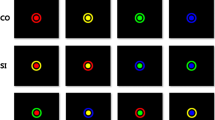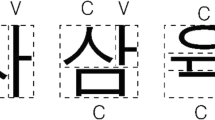Abstract
It has been suggested that the mental representation of numbers is spatial in nature such that numbers are ordered on a mental number line. In the present investigation we use a variant of the Eriksen flanker task requiring a magnitude decision (smaller or larger than 5) for a central target number by pressing a response button with the right or left hand. The target number is flanked by irrelevant distracters that are either identical to the target, different from the target but biasing the same response, or different from the target and biasing a different response. Response latencies and event-related brain potentials were obtained in a group of healthy adults. Besides the typical response congruency effects on response latency and the N2 component of the ERP, we observed several other effects. First, numerical distance of the target to the standard 5 influenced decision latencies and amplitude and latency of the P3 component with smaller distances leading to longer decision latencies, longer P3 latencies and smaller P3 amplitudes. Second, smaller numerical distance between target and distracters led to faster decisions for response congruent and to slower decisions for response-incongruent trials. For response-incongruent trials P3 amplitude was small/large and P3 latency was long/short for small/large distances. These findings underscore the spatial character of number representation and further show that the relation between targets and distracters, although task irrelevant, is assessed automatically with facilitatory and inhibitory effects driven by spatial distance on the mental number line.



Similar content being viewed by others
References
Botvinick, M. M., Carter, C. S., Braver, T. S., Barch, D. M., & Cohen, J. D. (2001). Conflict monitoring and cognitive control. Psychological Review, 108, 624–652.
Botvinick, M. M., Cohen, J. D., & Carter, C. S. (2004). Conflict monitoring and anterior cingulate cortex: an update. Trends in Cognitive Sciences, 8, 539–546.
Dehaene, S., Bossini, S., & Giraux, P. (1993). The mental representation of parity and number magnitude. Journal of Experimental Psychology: General, 122, 371–396.
Fias, W. (2001). Two routes for the processing of verbal numbers: evidence from the SNARC effect. Psychological Research, 12, 415–423.
Fias, W., Brysbaert, M., Geypens, F., & D’Ydewalle, G. (1996). The importance of magnitude information in numerical processing: evidence from the SNARC effect. Mathematical Cognition, 2, 95–110.
Johnson, R. (1986). A triarchic model of P300 amplitude. Psychophysiology, 23, 367–384.
Kenemans, J. L., Kok, A., & Smulders, F. T. (1993). Event-related potentials to conjunctions of spatial frequency and orientation as a function of stimulus parameters and response requirements. Electroencephalography and Clinical Neurophysiology, 88, 51–63.
Kok, A. (2001). On the utility of P3 amplitude as a measure of processing capacity. Psychophysiology, 31, 557–577.
Kopp, B., Rist, F., & Mattler, U. (1996). N200 in the flanker task as a neurobehavioral tool for investigating executive control. Psychophysiology, 33, 282–294.
Liotti, M., Woldorff, M. G., Perez, R., & Mayberg, H. S. (2000). An ERP study of the temporal course of the Stroop color–word interference effect. Neuropsychologia, 38, 701–711.
Moyer, R. S., & Landauer, T. K. (1967). Time required for judgements of numerical inequality [47]. Nature, 215, 1519–1520.
Niedeggen, M., & Rösler, F. (1999). N400 effects reflect activation spread during retrieval of arithmetic facts. Psychological Science, 10, 271–276.
Niedeggen, M., Rösler, F., & Jost, K. (1999). Processing of incongruous mental calculation problems: evidence for an arithmetic N400 effect. Psychophysiology, 36, 307–324.
Nuerk, H. C., Bauer, F., Krummenacher, J., Heller, D., & Willmes, K. (2005). The power of the mental number line: how the magnitude of unattended numbers affects performance in an Eriksen task. Psychology Science, 47, 34–50.
Parasuraman, R., & Beatty, J. (1980). Brain events underlying detection and recognition of weak sensory signals. Science, 210, 80–83.
Polich, J. (2007). Updating P300: an integrative theory of P3a and P3b. Clinical Neurophysiology, 118, 2128–2148.
Priftis, K., Piccione, F., Giorgi, F., Meneghello, F., UmiltÃ, C., & Zorzi, M. (2008). Lost in number space after right brain damage: a neural signature of representational neglect. Cortex, 44, 449–453.
Restle, F. (1970). Speed of adding and comparing numbers. Journal of Experimental Psychology, 83, 274–278.
Riba, J., Rodriguez-Fornells, A., Morte, A., Münte, T. F., & Barbanoj, M. J. (2005). Noradrenergic stimulation enhances human action monitoring. Journal of Neuroscience, 25, 4370–4374.
Simon, J. R., & Rudell, A. P. (1967). Auditory S-R compatibility: the effect of an irrelevant cue on information processing. Journal of Applied Psychology, 51, 300–304.
van Veen, V., & Carter, C. S. (2002). The timing of action-monitoring processes in the anterior cingulate cortex. Journal of Cognitive Neuroscience, 14, 593–602.
Vuillemier, P., Ortigue, S., & Brugger, P. (2004). The number space and neglect. Cortex, 40, 399–410.
Wang, Y., Kong, J., Tang, X., Zhuang, D., & Li, S. (2000). Event-related potential N270 is elicited by mental conflict processing in human brain. Neuroscience Letters, 293, 17–20.
Wendt, M., Heldmann, M., Münte, T. F., & Kluwe, R. H. (2007). Disentangling sequential effects of stimulus- and response-related conflict and stimulus-response repetition using brain potentials. Journal of Cognitive Neuroscience, 19, 1104–1112.
Zorzi, M., Priftis, K., Meneghello, F., Marenzi, R., & Umilta, C. (2006). The spatial representation of numerical and non-numerical sequences: evidence from neglect. Neuropsychologia, 44, 1061–1067.
Zorzi, M., Priftis, K., & Umilta, C. (2002). Brain damage: neglect disrupts the mental number line. Nature, 417, 138–139.
Acknowledgments
Supported by grants from the DFG (SFB 779-A5) to TFM. Also supported by the BMBF (contract 01GO0202).
Author information
Authors and Affiliations
Corresponding author
Rights and permissions
About this article
Cite this article
Fellbrich, A., Nager, W. & Münte, T.F. The mental number line electrified: brain potentials in a numerical flanker task. Psychological Research 76, 229–235 (2012). https://doi.org/10.1007/s00426-011-0409-5
Received:
Accepted:
Published:
Issue Date:
DOI: https://doi.org/10.1007/s00426-011-0409-5




